Community Gateway
Back to Gateway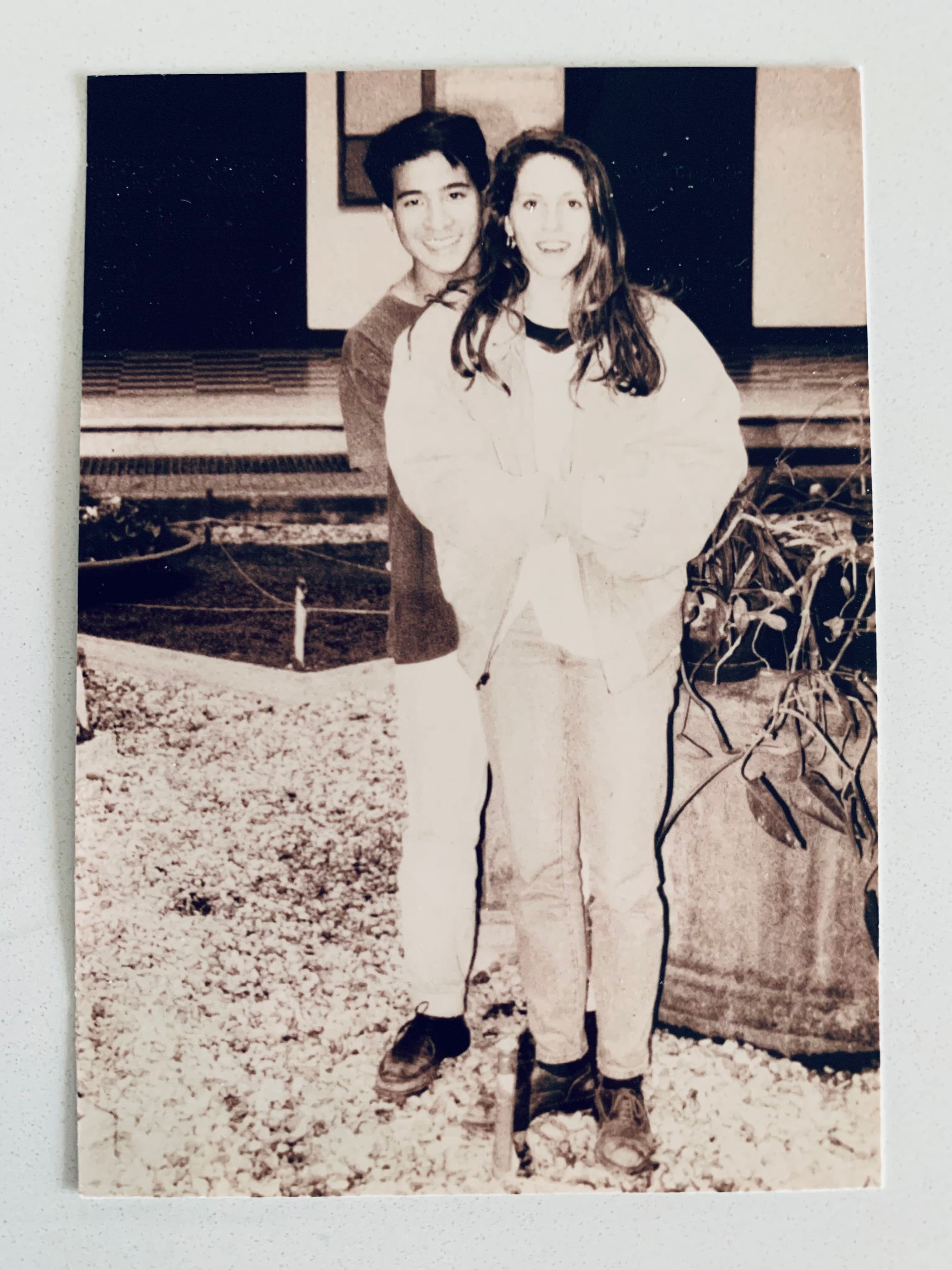
Eva: I'm from Rome, I was born there, since my parents met in Rome while working for F.A.O. Because of our international situation, St. Stephen' seemed like the perfect fit, and a natural transition from the international middle school I came from. I also loved the central location. Once I visited it felt like the most exciting high school for international students living in Rome, who wanted to be embedded within the city.
Ian: My dad was working for U.S.A.I.D. and our family moved frequently. I had been in boarding school since seventh grade and for high school my parents gave me a choice of various international high schools I could attend. I remember looking at St. Stephen's and finding it to be such a magical place, both because of the size of the school and of course the city in which it was located, compared to the other boarding schools. I became a boarder at St. Stephen's in 1987 and it turned out to be the absolute best choice!
Ian: I think those were the richest four years of my life. The international quality at St. Stephen’s is unmatched; everybody is unique and there is so much diversity. The arts programs really stood out because of the school's faculty and its location in Rome. Both Eva and I spent a lot of time drawing and painting, she was also very involved in theater. At night, I got permission to attend evening classes at the Accademia di Belle Arti di Roma which allowed me to further pursue those interests, so I was very appreciative of that flexibility that the school afforded me. The school trips were deeply memorable. There is something so adventurous and special about traveling and exploring different countries and locations with peers and teachers beyond the classroom, having dinners together and visiting sites.
Eva: There were so many memorable things; drama with Sandra is particularly memorable, but also art with Anita Guerra, Mr UIllman’s classes were extraordinary and the treasure hunts he organized were so memorable! And of course dance, with Roberta and Alice, who I know still teaches there. It's great how the drama program was as rigorous as calculus, which I also have fond memories of actually. Lots of drama in calculus sometimes. But in drama there was an expectation that if we were going to be part of that space, you gave your all. It also allowed me to sneak in more time with Ian, who was a boarder, because we would rehearse on weekends and late into evenings -sometimes as late as midnight.
Many of my teachers at St. Stephens have influenced the way I teach now, even anecdotally I still tell my students some stories related to my time at St. Stephens. My first oil painting was with Anita, I remember being so afraid to start and mess up that after staring at the canvas for a while Anita came over, took the paintbrush and painted a random squiggle on it to get it started. I was so shocked and upset at first, but then realized there is no “correct” way to start something new - you just have to give it a go. I still use this now as a professor of architecture to tell my students that there is no ideal way to start a project. You have to go for it.
Ian: I think every teacher was unique and had a lasting influence on me. The dormitory life was also really special, especially because my family lived abroad. I learned a lot from other boarders as well, how to make food in my room, do laundry, all the practical things.
Eva: And also, we started our life partnership at St. Stephen's, it's where we developed these little rituals. It was pre-phones and pre-internet, so we devised different ways to communicate. I would get to school really early in the morning with my father who worked at F.A.O., next door, and the only way to reach Ian, as I couldn't call, was through this system we developed using a string that Ian hung from his third-floor window.
Ian: We created a DIY doorbell system so I would know when she arrived. It was a weighted string that I would lower out of my window, and when Eva arrived she could pull it, and it would tap on my window so I would know when she was there, and I could go down to meet her.
Eva: Yes, he would put it down the night before, and I would "ring" at 7:30 in the morning, so we would have some time together before class.

Ian: Yeah. I learned so much as well; I spent a lot of time on my guitar playing and learning from other boarders whose passion was music. Everyone on my floor was into a different thing. We had all kinds of talents. I also spent a fair amount of time skateboarding and exploring the city.
Eva: For me, the passion existed early on. I went to St. Stephen's with a passion for drawing and a passion for math and science. However, I thought I wanted to go into theater and dance because I loved these performing arts as well. St. Stephen's allowed me to keep exploring my passions at a rigorous level since the drama and dance programs are very robust. I developed my passions by combining the arts, drawing, thinking through making, and the rigor of physics and calculus, which I love. Still, to this day, I look at my notes and realize I also had a lot of fun. I enjoyed school. Already in my freshman year, I realized that I was always drawing architecture whenever I had a moment; while waiting for the bus or whenever I could I would be either in front or inside of a church or in a piazza, just drawing, sketching, and absorbing everything. My passion for architecture came from the marriage of my interests, which I think St. Stephen's supported quite well. And there was also the magic of being in Rome.
Ian: On my side, I started at a performing arts school in Massachusetts studying painting, violin, and ballet before attending St. Stephen's. Drawing and painting became my passion and St. Stephen's allowed me to continue that. Lucy Clink, my art teacher, provided a lot of inspiration and support; I would do fine arts in the evenings, too; Eva and I would often venture out to churches to sketch together. That was a nice way to deepen our appreciation of art and architecture. I went to art school after St. Stephen's, thanks to Lucy, who guided me to the Tyler School of Art at Temple University. I went to Philadelphia for a year, and it was there that I realized there was another dimension to my interest in art, so I switched to studying Architecture in North Carolina and found my way back to something I had known all along.
Eva: I went to Madrid to study architecture. I didn’t have a great understanding of the different architecture schools then, just that I wanted to study architecture. Originally I was considering the UK, but with some fatherly sway I decided on Madrid and stayed there for seven years for an undergrad and graduate combined program. In retrospect, it was an odd choice since it was the only country in the world that did not recognize the IB, which I had passed with top marks. But that accomplishment didn’t do anything as I had to take a whole new set of state exams to be admitted in the Spanish system. It wasn’t an easy move to go from the international atmosphere of St. Stephens to a single language, single nation system. I had to re-learn technical terms for physics and math in spanish. It was a bit like my military service!
Ian and I were together but physically apart during that time. We would try to meet up at least twice a year and figure out where we could go in the world that could support us both and, somehow, our families. So we decided on New York, which was supposed to be a two-year adventure [laughs], and here we are, twenty-two years, and two kids later.
Ian: We spent many years apart, and that was before cell phones and the internet, so we used a lot of payphones and phone cards, and we sent many letters. We have so many boxes of letters and mixtapes [laughs].
That was an exciting moment after St. Stephens. I'd gone to Philadelphia for a year, and then I went to North Carolina, NC State because my dad had retired and our family settled down there. Eva and I traveled to see each other every chance we had. After completing my undergraduate degree, I went to Madrid to join Eva again where she was still finishing school. Meanwhile I was freelancing for different architecture firms in Spain. After Eva completed her studies we moved to New York. It was a meeting point between Europe and the U.S. New York which was closer, logistically, for our families. It was also supposed to be a short period where we would stay a few years and then possibly move to Europe. Although, once we were in New York and we experienced the rich multiculturalism, which simulated a lot of St. Stephen's diversity, it seemed a natural place for us to settle and over time our roots deepened and we’ve been here since.
Eva: Now we have two children, an architecture practice and teaching positions in universities here so while we try to get to Rome whenever we can, New York feels like home. I think the strangeness of New York felt right for us. Curiously, I have never felt foreign in New York. I remember going to Madrid, and even though I'm half Spanish, it felt utterly foreign to me, and I was treated that way. Of course, Madrid at that moment was less diverse than it is now. In New York, because most people come from different parts of the world, it has the international vibe that I had growing up in Rome.
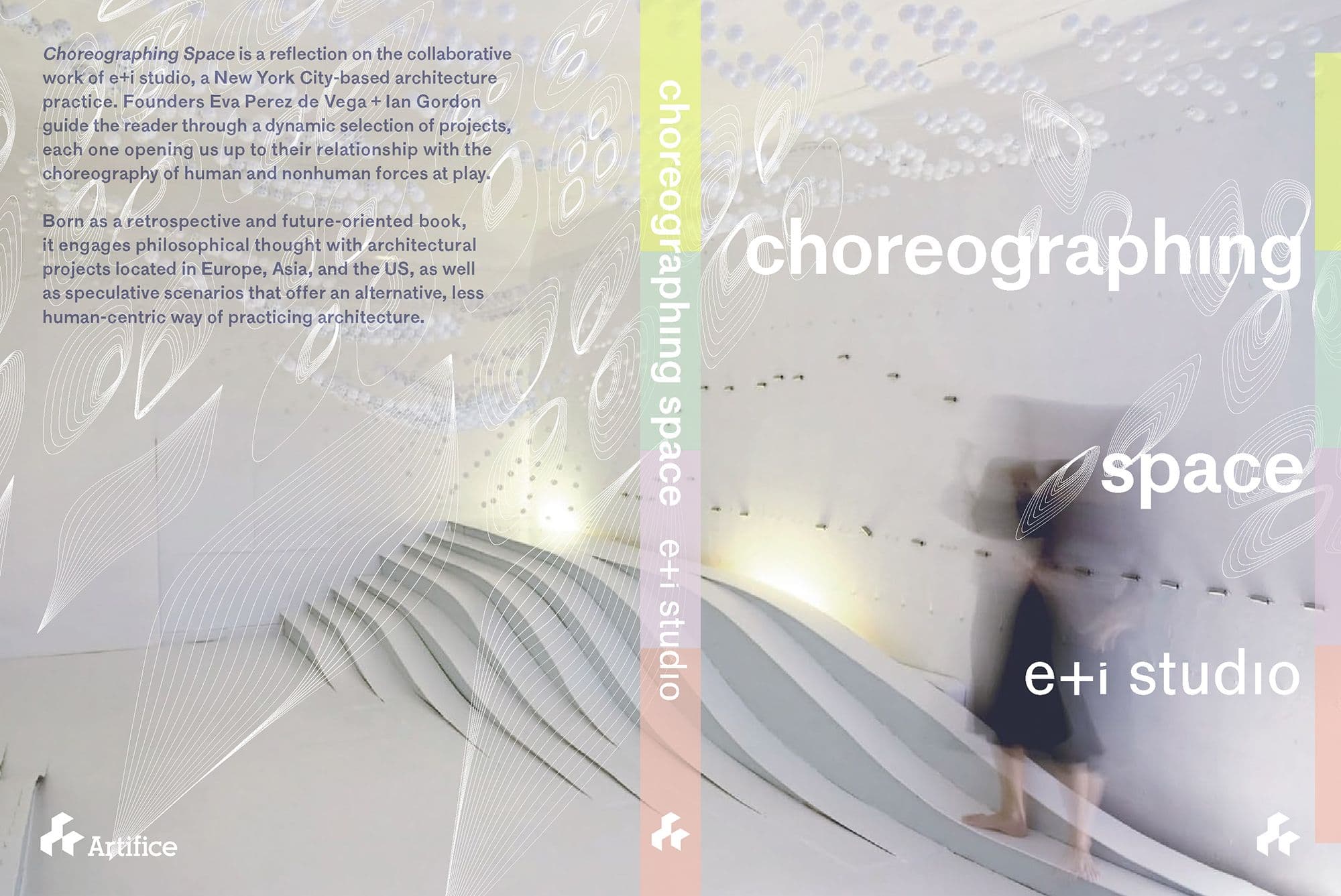
Ian: Our e+i office emerged kind of naturally. When we first moved to New York, we worked for different architecture firms, making a living and gaining professional experience. We were simultaneouly collaborating on projects after hours, and I think it all started in 2007 with our first design-build project "Choreographing Space."
Eva: Prior to 2007 we had already collaborated a little bit on projects and continued to do so whenever we could. It was also a time when we were both working for high-profile international architecture offices, and we were pretty burnt out. I had decided to go back to dance for a few years to explore the dance scene in New York, so I auditioned for the professional training program at the Martha Graham School of contemporary dance and got in. I also started teaching architecture and design at Parsons to support myself financially. For a few years I was in tights dancing in the morning, and an architecture professor in the afternoons! Ian had decided to do graduate studies at Columbia which allowed him to explore architecture differently. So, it was a moment where we were thinking about our voice in the profession, and started doing projects with dancers and artists in NYC.
Eva: So I was dancing and involved in the dance scene here in New York. Ian, you were still skateboarding. Ian was quite well-known as a skateboarder at St. Stephen's, and still skates today!
Our “Choreographing Space” project brought all those things together and in that sense was pivotal and seminal for the founding of our practice. So much so that we gave our first book publication that name "Choreographing Space."
We received a grant and a space from an organization that emerged after 9/11 with the mission to revitalize downtown, which became a ghost town. The Lower Manhattan Cultural Council (LMCC) matched artists with spaces downtown that were left abandoned after 9/11. It was a time when nobody wanted to be downtown. The project emerged from this idea of "how do we think about movement and built space?" How do you dance the city, skate the body and move through the environment? So, we design-built and curated public events for "Choreographing Space," with a team of artists and supported by the LMCC. We collaborated with dancers I had met in my years at Graham and people Ian had met through his different offices and school.
Ian: It was a good collaboration, a real design-build project that allowed us to combine our various interests. It was from that project that our office, e+i studio, emerged. The name e+i has many meanings; it's obviously the initials of our first names, but it also refers to exteriority and interiority, architecture and interiors. Lots of different ideas flow through it and that has formed the rubric under which we continue to explore our various design agendas.
It was after winning an International design competition for Ceramics of Italy that we decided to establish our practice more officially as a registered legal entity e+i studio LLC. I left the office I was working at and joined Eva in the office full time.
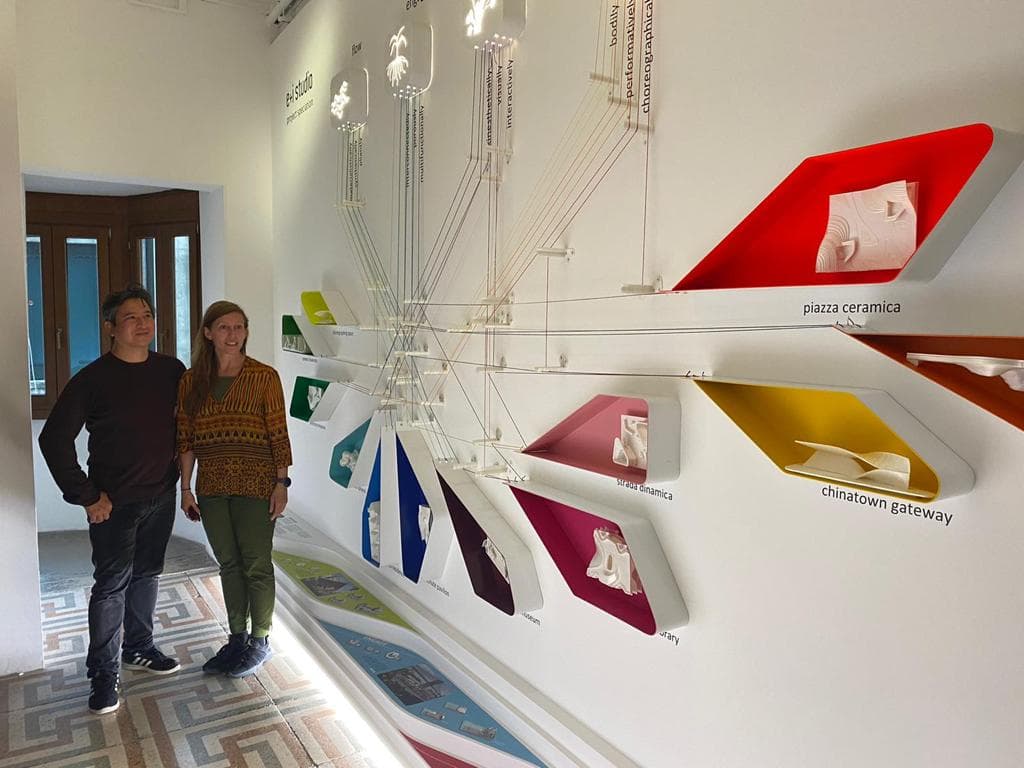
Eva: That's a term that needs unpacking. It's embedded in the way we think about materials and the way we think about our position, as humans, in the larger environment. So, it's always there, latent, but through certain projects, being invited to the Biennale, through books, and reflecting on our practice, we realized that a lot of the themes that were emerging were related to an understanding of the fluidity between architecture as human-built and the environment that is not human built but still has our imprint. And we understand ourselves as part of that, a part of nature- as nature. Architecture's practice has something problematic in it. It understands itself as being just for humans; it is very human-centric practice. In a way, this idea of empathy is not just, we're feeling sorry for what we have done in the world, or we want to extend human meaning to non-human life but rather to question the way we do things both as architects and to question the ecologies that our buildings change and make possible. So, it's a mode of reflection, but it also has clear specific repercussions; we can't keep sourcing material from the environment without any awareness of where those materials might go afterward or without looking at the cyclical nature of both materials but also the practice of having people or goods traveling far distances. Everything is quite interconnected. And the same sort of empathy that you can have for someone of your kind, so to speak, should extend beyond people to the larger planet.
Ian: We can't be human-centric; other actors are affected by what we design. We are also facing an environmental crisis, which is upon everybody.
Eva: We also started thinking about putting ourselves in strange situations like, what if we had not designed to keep animals out? Animals are now under extinction because of us. What if they are part of our architecture? What does that do? How does that radically change the way we think about architecture? And even something very practical is architecture's repercussions on avian life. In New York City, for example, many birds collide with buildings because we haven't considered migratory paths. The built environment is one of the root causes of extinction. So, we shifted our gaze to something beyond just human concerns to provide opportunities for the development of the practice as something that could be even more innovative, exciting, and considerate of all forms of life.
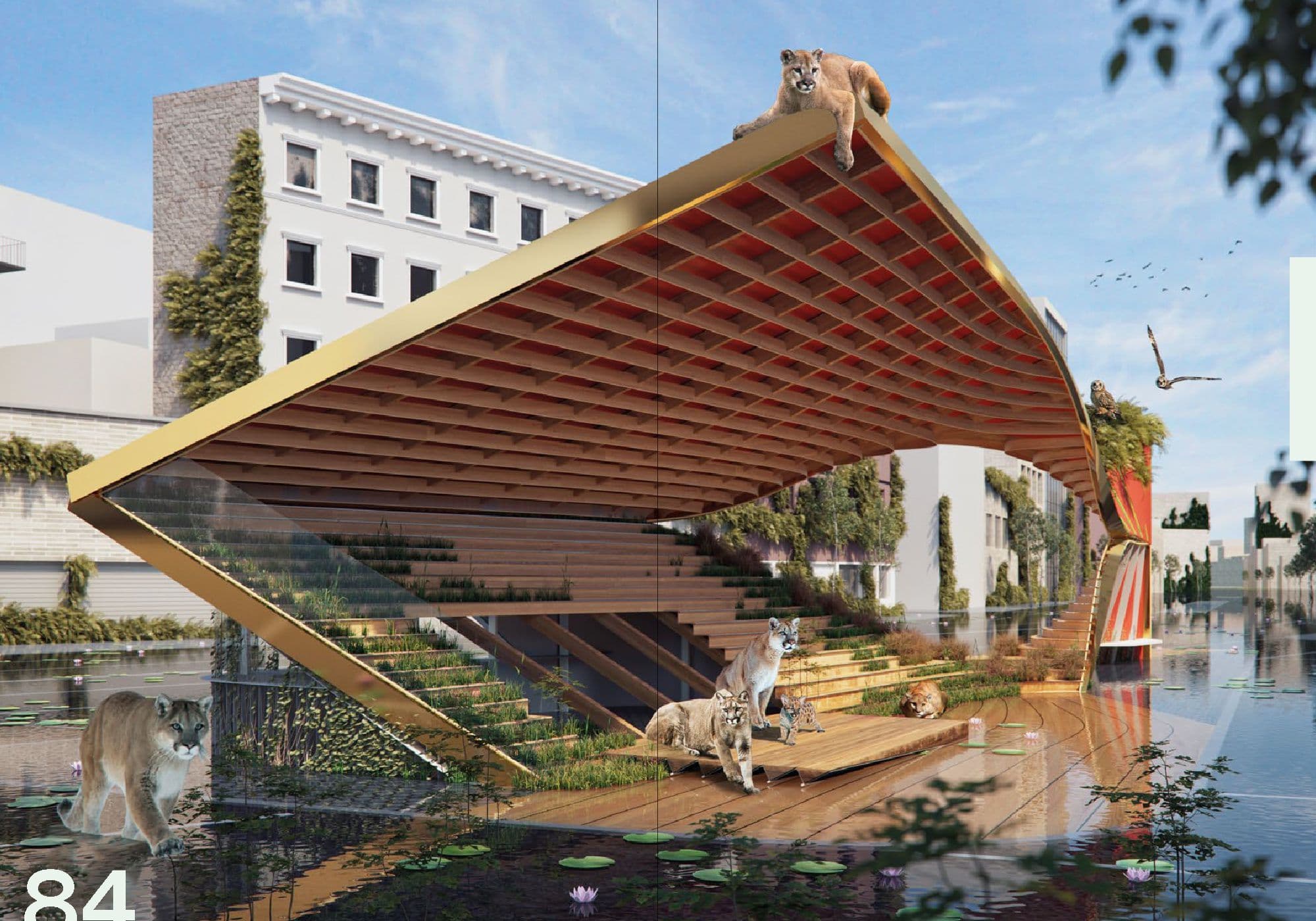
Eva: I think that's the question. We are trying to open up that possibility, and it came about as a kind of self-reflection on our practice, in the way we had been practicing together for ten years and practicing separately almost for twenty; we started thinking that architecture as a practice is inherently human-made, inherently just for human concern and that feels wrong. It cannot be right. And there are different ways of thinking about it, but it does require some degree of radicality, a kind of questioning of everything. And so, we started with that question. We are one of many species here. We took our projects and did what I call "speciation." We tried to categorize them based on specific interests, also understanding the philosophical underpinnings of these sorts of groupings. So, we call these: flow, engage, gather, and perform, which we thought our projects were doing, but they also have a particular resonance with the other creatures in our environment. And so, it's both a reflection, a self-critique, situating ourselves within the discourse to move forward as educators, because we are professors. We are responsible for addressing these questions very seriously in our work before we can do that with the students or at the same time as we do that with students.
The Biennale helped us, as it gave us a space to reflect on that. It was interesting to see that there were a lot of projects asking similar questions as well. We're in a moment of reckoning as humans and as people who make things in the world. This footprint isn't necessarily all negative, but, either way, we need to be aware of what it is.
Ian: There is a self-reflective aspect to it where we look back at themes in past projects and energize new projects as the themes are reinterpreted and evolved. We think not just about animals but also the wider environment; ecologies, water, land, and weather are all part of the environment we're designing in. We also reimagine projects through a lens of speculative fictions in which we imagine alternative futures for the projects and in so doing, these scenarios can have real effects later in how we envision new projects. These exercises sit in the back of your mind, and they affect the new projects.
Eva: The degree has helped me make connections between things that are interesting to me more theoretically, and the practice of architecture. At first, I had to delve into the world of philosophy to gain my footing. I'm now in the dissertation process, and it's an exciting moment to bring those multiple worlds together; they're mutually informing. Many of the writings that I have done, including in our recent publication, have opened up questions, from a philosophical point of view, of themes that interest us architecturally. Part of the dissertation involves questioning and exploring the notion of human exceptionalism in architecture and its philosophical roots.
While both philosophy and architecture can be very patriarchal, Philosophy has allowed me to question and hear other voices - to open up to different points of view that might not be understood as part of the canon. Eco-feminism and animal ethics, for example, have been helpful tools to look at architecture through different lenses.
Ian: There are always a few key projects that stand out. The first project we collaborated on for lower Manhattan, Choreographing Space, was a favorite. We also won a competition to work with Ceramics of Italy, and that was a very natural, enjoyable collaboration with an Italian client and product industry.
Eva: Absolutely. Working with Italian clients has been one of the most satisfying collaborations for me.
Ian: Even though we were in New York, we could communicate in Italian, which created more direct engagement. We have other ongoing projects; we were shortlisted for a competition here in New York, in Chinatown, and that was a unique project. We were shortlisted, and while we didn't win it, it resonated on many levels.
Eva: The project touched on issues of identity, and it was meaningful because we spend so much time here in Chinatown; this is where our office is, where our kids first went to school. We had to ask ourselves, "what is the identity of Chinatown? What does that mean architecturally?"
We like all our projects, but some are pivotal in guiding us towards the kind of work we would like to keep pursuing, and ways we can continue to interrogate the way we build as humans in a world that has so much of our built presence. As part of that research, we have a small plot of land upstate where we are considering how to source materials from the land without bringing things from outside and questioning how we can consider the other animal and plant and fungal life around us. So, we're doing experiments with enclosures where other animals can also thrive, rather than be displaced. We're investigating whether we can have human comfort while providing opportunities for life to continue thriving.
Ian: I guess that's our latest favorite project. It's an ongoing laboratory, and it's another design-build project, just as our very first one was. We'll have an idea, test it out, and build it. It's also a nice getaway from the city.
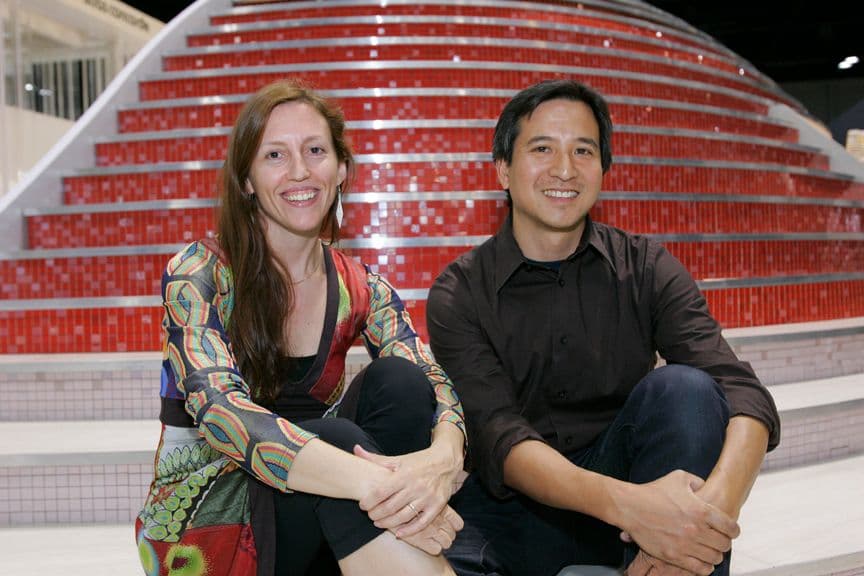
Ian: It's always a little complicated. Having our studio has been challenging, but it's also a hub that is somewhat adaptable, and we've managed to explore our different interests within this office, whether it's teaching digital workshops, working on residential projects, commercial projects, or collaborations with dancers, they all fall under this rubric. The studio is a functional, flexible entity. Our studio helps us surmount challenges. We don't have a strict type of project that we work on; we follow the agenda of the relationship between exterior and interior, which flows through everything. We're also still evolving.
Eva: I feel like we're on a path but it's almost like a python path, you know? It isn't necessarily predictable. Otherwise, we probably wouldn't still be doing this. A few years ago I would never have imagined building structures to support non-human life and humans to coexist or have their domain. But this is what I find most interesting and necessary now. We realized from working in these great architecture offices that there are many different ways of practicing architecture, some more interesting than others. Architecture can be like a research laboratory. We certainly do lots of regular architectural practice projects, such as renovations and residential work. These can also be exciting because the clients are always different. Still, we see our practice as a neural network with various tentacles that reach out to other areas of interest. We haven't followed a single path.
Eva: In many ways, today's students are much more forward-thinking than we were. There are more opportunities for them to test out different careers. I don't think that was available to me, or I didn't know it existed. If you have the chance to do that, do it. Do the internships, the summer programs, and the workshops because they will give you footing and a chance to further explore your interests. Ian and I teach high school students over the summer, in an intensive program that gives them a taste of what it might be like to pursue architecture or interior design as a career path. These are the opportunities I wish I had, because the intensives allow students to see if this is a path that might interest them or not. We are actually planning a workshop at St.Stephens next summer, and would love to have St. Stephen's students join one of our workshops!
Ian: I agree. I think early work experiences can be super valuable. High school is the formative time when you are figuring out what your identity and interests are, and St. Stephen's is a special place because you can be comfortable no matter who you are; there's a lot of diversity. It's essential to feel comfortable with who you are, your background, and whatever it is. High school is such an exciting, formative time! With regards to the future, the job descriptions you see now might change because of emerging technologies and changing situations. It's essential to be comfortable with and hear your instincts and follow that. The other thing we didn't have, social media, is another opportunity for students to stay connected and build community. It took a lot of work for us to maintain those bonds. I think this student body is more networked than we were when we graduated, and so hopefully, that provides a stronger glue moving forward.